Stoschek Goes Black. Probably Will Go Back
- Christian Hain
- Mar 12, 2018
- 10 min read
Updated: Mar 23, 2020
(Berlin.) The first week of February and arriving at Julia Stoschek Collection for a new show, I felt desperately in need of a coffee, black and strong. This, I assure you, was only due to the weather, it bore no connection to the artist, Arthur Jaffa, or the announced “black arts” – art tackling “colourful” (not: “-ed”!) issues and isms.
It was freezing cold in Berlin, yes: motherf%ù& cold bro, you know what I’m sayin’? - You will excuse my occasionally slipping into stereotypical “black” slang over the course of this article, please. (Awkward.) - Arthur Jaffa is not a visual artist by training. He’s made a living in film and music since the late 1980s, working as a cinematographer and director for Kubrick and Beyoncé(‘s lil’ sista), among others. JSC promised an artist occupied with music, black, negro, Afro-, African-American music from Jazz to Rap. - Call it whatever you like, but I must insist once again: “African-...” is one of the most ignorant terms ever. There are people with black-toned skin living in India and the Pacific whose ancestors left Africa at about the same time as your common Caucasian, some 125,000 years ago. They're moving here, too. People trying to be “correct” can be quite funny, though: at Berlinale I overheard a German journo praising his hairdresser “from Cameroon, or where he’s from”, desperately trying to convey an information without saying the words. And before you start railing: For no particular reason, and entirely coincidental, my recent readings involved a rather disproportionate share of black authors, James Baldwin, Jean Toomer, most recently Ralph Ellison (while Iceberg Slim has earned a place in my heart long ago, obviously). Can nobody say, I’m hostile to anything black - this very moment Migos are playing on iTunes!
Expectation influences attention, and first thing I noticed at the press breakfast with art (some tasty donut balls!) was: “not much browner than the other guests – wait, what: Arthur is a she?” This was actually the curator who already masterminded the show’s first rendition at Serpentine Galleries. Saying “renditions”, the title is interesting: A Series of Utterly Improbable, Yet Extraordinary Renditions. I still stumble over the “yet” (and a potentially missing second comma) - why not “thus”? Im-probable: not probable, unexpected, out of the ordinary. Extra-ordinary (“extra”: out of, from Latin, meaning “outside”; but fine: Latin is “out”). And why “renditions”? Not original creations, but stagings, repetitions of something that was conceived prior to the event. The Berlin show is larger than the one in London - that, besides, used the same title -, because everything’s bigger in Berlin (that’s no evil thing to say, I hope; changing “Berlin” for “black” would be, apparently, I’m told).
It’s also a double premiere: the first solo show of any artist at Stoschek’s and her first collabo with Serpentine. How should we imagine this: “Hey, Hansi, it’s Julie, fancy doing some stuff together? Yeah, let’s have coffee soon – you pay!” But back to that press tour, and breakfast, with Berlin’s hottest billionaire (her liaison with the CEO of Germany’s equivalent to NewsCorp has been made public a while ago). Stoschek’s bougie, dabbing in black leather trousers and a flaming tee. Arthur Jaffa on the other side looks how you’d imagine your stereotype (yeah I know, you don't have those) of a relaxed black artist: Base cap over bandana, and is that a Wu Tang logo on his sweater? He even sounds like the guy you’d ask to partake at eight in the morning, then puff away the day/night/week/month, and the next as well. Talking about New York, he was lost for a name at one point, searching, struggling, hands painting circles in the air: “how’s it called, that round thing?” - “Guggenheim?” that curator jumped to his help, “Oh yeah, huh huh!” I like the chap.
He occupies an interesting position: Yes, Arthur Jaffa is part of Gavin Brown’s Enterprise/stable, yes, he’s sold to Stoschek, but no: he won’t depend on them. He could say, “Screw you, I’m going home” any day of the week, and just pay his mortgage with music and film again. We felt humbled when he announced: “What New York was to Jazz, Berlin is to Techno”. Truly modest for an American who, after all, has all the right to pay Detroit the respect it’s due. If I were writing for – well, you know the names –, I’d be forced to alter certain defects in his language, though, referring to himself as a “black” artist instead of “African-American” (ever annoying, people not talking like they ought to, thanks God, there are the enlightened few to guard them).
They told us of a theory, black Americans traditionally focus on performing arts, dancing, singing, because slaves had only slim chances to create, and keep, artefacts. Sounds legit, and yet: Mama Africa never cared that much for other arts either, all sculptural “arts premiers” and their influence on 20th Century European art history aside.
Let me digress here for a moment:
Black American music history would make a fascinating topic for any artist, at least if he includes all sorts of contradictory phenomena. Some would go so far and say, all original American music is black just like all other original American creation and thought is Jewish. Now consider this: “... a genre of music that presented a stereotyped image of black people. (...) Blacks were portrayed as making money through gambling, theft, and hustling, rather than working to earn a living, (...) songs portrayed blacks as "hot", in this context meaning promiscuous and libidinous. They suggested that the most common living arrangement was a "honey" relationship (...) blacks began to appear as (...) given to drunkenness and gambling, utterly without ambition, sensuous, libidinous, even lascivious. (...) Blacks were portrayed as inclined toward acts of provocative violence. (...)”
As much as it seems to fit – change “drunkenness” for “being stoned” and “honey” for “bitches” -, this is not copied from an encyclopaedia entry on Hip Hip, but the Wikipedia article on 19th Century “Coon Songs” (classified as “racist”, though some black singers made a lot of cash from them too). Potential continuities that deserve more in-depth research, don’t you think?
Or take the paradox of gangsta rap with its lyrics from the thirty-odd past years that could be summed up easily in the words: ”Yo, wez a gang of dope dealin’ niggaz; you say wez a gang of dope dealin’ niggaz, youse fuckin' racist! (word!)” Something faulty with the logic here, methinks. And yet, once again: I love HipHop (not merely for my latent misogyny. ... I hope).
In the end, it turned out different than expected. Arthur Jaffa is a cinematographer/director in the first place, and acting as an artist in an art context, he won’t do much else than arranging images. Few works do really link to his musical background and interests. And with these words, let’s finally start into A Series of Improbable, Yet Extraordinary Renditions:
The official starting point is on ground floor, but you may also go upstairs first. You’ll find ring binders on a table there, lots of them, a collection of newspaper articles, book catalogues, and photos of art and cultural artefacts - An artwork very much executed in an Abby Warburg state of mind. Documents in no apparent order, some of African, some of American, some even of Berlin(?) origin; left without any comment they invite to study and (over-)interpretation. A monochrome wallpaper in the same room features an enlarged press photo with the headline: “3 Negroes lynched at Duluth, Minnesota, for rape, October 1919”. It’s graphic. (Tell me, would it really be any better if that read: “3 African-Americans...”? Too many people tend to say “yes” nowadays.) 1919, that’s not so long ago you’d think, and yet: almost a century. It won’t interest you at all, but I own a Packers shirt with the same year printed big on the chest, the team’s founding date. History come alive, dark history, and how much has changed? The (readymade) artwork is not intended for a salute to early #metoo campaigns, but seeking to highlight the wilful murder of (presumably) innocents, their true crime being black. A historic #BlackLivesMatter, never confuse your hashtags. Jaffa opposes it with a photo of heavily armed black men throwing gang signs.
In the adjoining room, a violent thumping soundtrack accompanies a no less brutal video. That film has an Atlas-sian vibe to it, again.
Back downstairs, every visitor gets a headphone with an inbuilt mp3 player (or is the sound streaming from somewhere?) With four audio channels for a lot more films, you invariably get lost and mix your own soundtrack more or less matching the visual experience. This is probably not unintended.
Scattered over the space, all videos appear like collages of images past and present. Visual mixtapes of photos, film, YouTube and video game clips. A singer on stage, a household discussion, an all black rodeo in full Western gear (Django Unchained Reloaded?), close-ups of a black Fidel Castro - well: a black blackbeard in camouflage - talking, close ups of somebody watching the same film as you, in the film. A slideshow with Heavy Metal and Rap performers in costumes, Christian imagery, horror film stills, and wait, was this a Basquiat? The soundtrack changes from orchestral and electronic to beat’n’shriek-ing discords. And always the question: What channel am I on? Somewhere, a preacher’s preaching and the congregation repeats his every word, “Scorpio”, “Aquarius”, ah: constellations. Next screen, “I will miss the Boston Marathon. All my friends will be wounded in the bombing.” What?! And where do the Italian subtitles come from suddenly? Mourning black women, but what do they mourn, or whom? Might be this audio, their relatives perished in some shooting or other (excuse me, Americans, but it’s hard to keep up with all your citizens going postal ... And still, if ever I moved to the Land of the Free, first thing to do would be exercising my right to buy a firearm).
Videos might not be the best thing here.
Photo wallpapers are more interesting: A pledge of allegiance in a black elementary school somewhere in the South, 1900, bizarrely anticipating a Hitler salute. A collage with Mickey Mouse and a Voodoo priest, titled Mickey Scorpio (but that film was only about star constellations, right?). Never noticed the resemblance, but it all makes sense now. (?) American “Culture”/society meets a hidden subculture. A plastic photo, or: "vacuum-formed plastic relief", of Ex-Slave Gordon with whip marks on his back, 1863. The Soledad bothers storming a courthouse (never heard the story before ->Black Panthers). The word "Slaver" in Slayer band typo, not entirely unreasonable, there might exist a certain intersection between people listening to metal and people cherishing the old times.
There’s black on black violence too, and lots of it. Not 'straight outta Compton', but the African blueprint for Bloods and Cribs: Hutu and Tutsis. Rwanda’s tribal war was savage (and besides: not racist to modern standards; afaik at least, the Hutu genocide-d the Tutsi without ever resorting to “racist” language. Neither did the Nazis, btw. But hey, go on inquisitioning speech, that will surely be the answer to everything.)
The upstairs video is playing again, with close ups of mutilated corpses rotting on Rwandan country roads. Less nauseating but even more impressive: a Boltanski-an pile of clothes on a photo from a Rwandan War Memorial. (But somehow it must all have been the White Man’s fault, cannot be otherwise.)
A newspaper drawing, an early comic strip from before there was photography, reporting on a Horrid Massacre in Virginia – that’s the headline -, over in the colonies as you still said back then. This time, it’s blacks slaying whites and a heroic farmer securing his wife’s escape. I’m not sure about the facts. But are our newspapers more objective? Tear out a moment from the book of history, enlarge, and put it in our face; that’s art.
Black Flag, a confederate flag painted black. The accompanying text recounts shortly – very shortly – the history of the flag, and how, “today, for many Americans, (it) is a representations of slavery, hatred, and white supremacy.” There might have been more to the cultural North/South divide. (I dimly recall a story of W. Henry describing an old, colonial, European, aristocracy of the South as opposed to senseless Yankee mercantilism. In the end, the Yankee wins, but something is lost).
Arthur Jaffa is a remarkably cooperative artist who insisted on inviting two bishes, yo, no: sorry, that darn Hip Hip lingo again: two female artists, presumably of African-American origin, to his show. Frida Orupabo, the first of the invitees, is playing with roles, I guess that’s how you call it: A man giving birth, &ct. Just like Arthur Jaffa, she's in love with collages.
The second is Amy Smith and what at first seems like trivial scenes of (black) street life, “backstreets and black-streets”, are in fact unidentified stars, jazz legends mostly, mingling with Average Joes (or “Average LeDaDeKawhis”, gotta love the creativity of Afro-, darn, again: African-American given names). Occasionally, she painted over them, very subtly. This overview on her work from the 1970s to the 1990s is not without interest, but not particularly striking from a photographic point of view either.
And suddenly, I got it. The show’s idea and intention, they hit me right in the face like a mothaf--- Tyson jab: We can do everything the same as you. And we do. ‘Nigger is the woman of the world’ (calm down, it’s a quote, slightly altered, but that’s ok! Put down the torches, now!). These contrasting scenes of violence and counter-violence, white and black, black and white, black and back, scenes of people killing each other ultimately regardless of colour - effectually discovering the same red to the eye -, they might be a gesture of reconciliation. Bad things happened and happen still, but violence is a part of the human condition, neither black nor white, no: both. (“No matter, if you’re black or white” - bad, Michael, bad: you’re neither black nor white, you’re the same.)
Of course, there's also a danger in equality. Assimilation, uniformity, loss of identity and diversity: the perils of unity. Not biologically different, and no longer culturally either. All the same, equal. In the long run it seems almost unavoidable. Reduction of complexity is a function of augmenting mass in a static space. Admittedly, it would be a provocative thing to say: “Negroes lived in (/came from) Africa and had their own cultures; African-somethings are here, with, and exactly like, us.”
The old world knew countless cultures mutually excluding each other, where our brave new only knows one, united in boredom (and/by the market). There’s no return, thanks to mass and technics.
And maybe I’m saying all this only because I’m a white male, and we rarely lost.
Jordan Wolfson paid a visit to the public opening, or his doppelganger (/puppet/robot). He did not beat up anyone, but might have enjoyed the violence. The opening was crowded again, and this time there was not even a performance (thus: no nudity). Maybe many came because JSC changed the opening hours: It’s only the weekend now. That’s a pity, and honestly: Ms. Stoschek could pay her interns fulltime.
Arthur Jaffa, A Series of Extraordinary, Yet Entirely Improbable Renditions, 11 February-25 November 2018, Julia Stoschek Collection
World of Arts Magazine - Contemporary Art Criticism

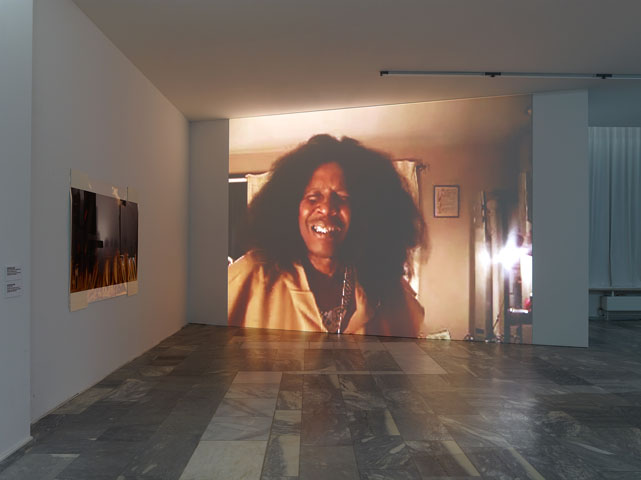

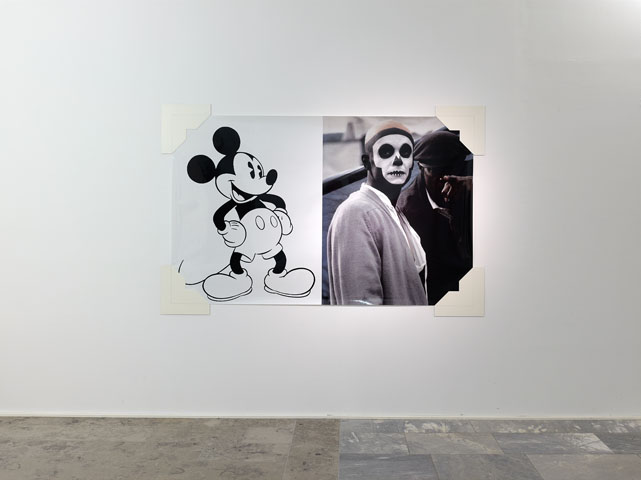

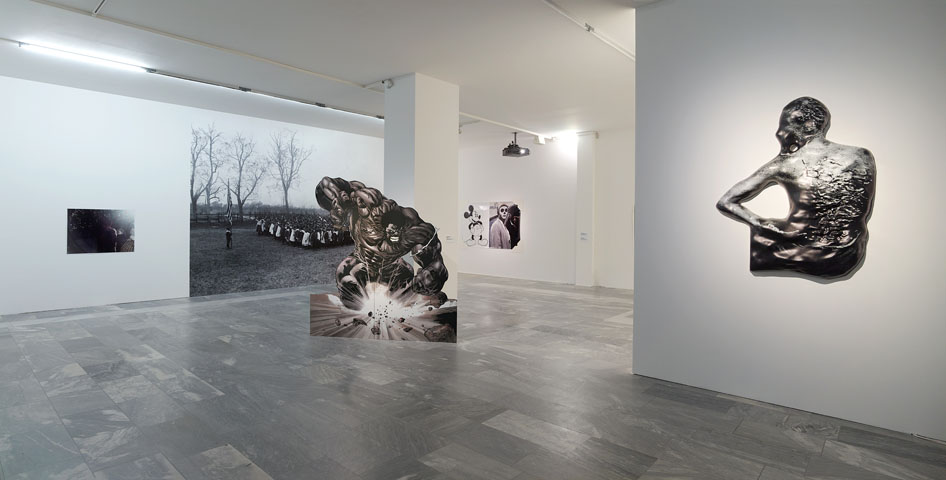

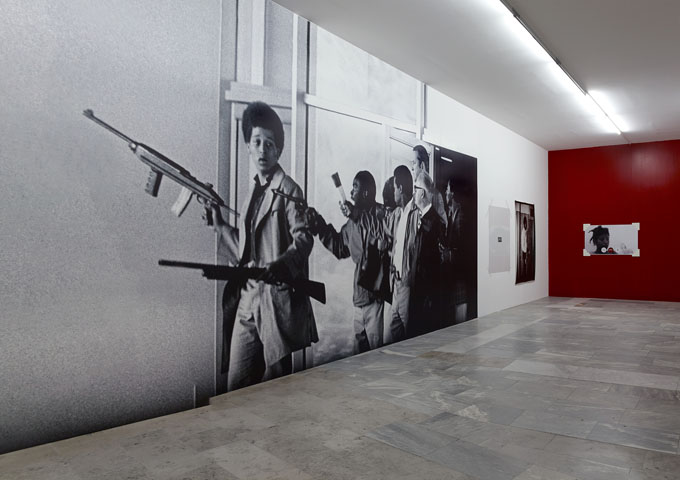

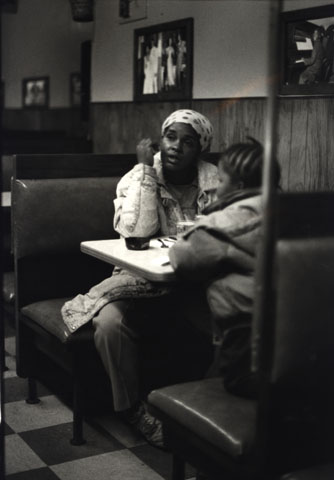
Comments